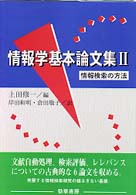- ホーム
- > 洋書
- > 英文書
- > Science / Mathematics
基本説明
New in paperback. Hardcover was published in 2003. Published in collaboration with NWRI - National Water Research Institute, USA.
Full Description
Chittaranjan Ray, Ph. D. , P. E. University of Hawaii at Mãnoa Honolulu, Hawaii, United States Jürgen Schubert, M. Sc. Stadtwerke Düsseldorf AG Düsseldorf, Germany Ronald B. Linsky National Water Research Institute Fountain Valley, California, United States Gina Melin National Water Research Institute Fountain Valley, California, United States 1. What is Riverbank Filtration? The purpose ofthis book is to show that riverbank filtration (RBF) isa low-cost and efficient alternative water treatment for drinking-water applications. There are two immediate benefits to the increased use of RBF: Minimized need for adding chemicals like disinfectants and coagulants to surface water to control pathogens. Decreased costs to the community without increased risk to human health. Butwhat,exactly, isRBF? In humid regions, river water naturally percolates through the ground into aquifers (which are layers of sand and gravel that contain water underground) during high-flow conditions. In arid regions, most rivers lose flow, and the percolating water passes through soil and aquifer material until it reaches the water table. During these percolation processes, potential contaminants present in river water are filtered and attenuated. If there are no other contaminants present in the aquifer or ifthe respective contaminants are present at lower concentrations, the quality of water in the aquifer can be ofhigher quality than that found in theriver. In RBF, production wells — which are placed near the banks ofrivers —pump large quantities ofwater.
Contents
Systems.- Conceptual Design of Riverbank Filtration Systems.- American Experience in Installing Horizontal Collector Wells.- German Experience with Riverbank Filtration Systems.- Riverbank Filtration Construction Options Considered at Louisville, Kentucky.- Operation and Maintenance Considerations.- Contaminant Removal.- Removal of Pathogens, Surrogates, Indicators, and Toxins Using Riverbank Filtration.- Riverbank Filtration Case Study at Louisville, Kentucky.- Reduction in Disinfection Byproduct Precursors and Pathogens During Riverbank Filtration at Three Midwestern United States Drinking-Water Utilities.- Occurrence, Characteristics, Transport, and Fate of Pesticides, Pharmaceuticals, Industrial Products, and Personal Care Products at Riverbank Filtration Sites.- Effectiveness of Riverbank Filtration Sites to Mitigate Shock Loads.- Riverbank Filtration as a Pretreatment for Nanofiltration Membranes.- Water-Quality Improvements with Riverbank Filtration at Düsseldorf Waterworks in Germany.- Research, Needs.- Infiltration Rate Variability and Research Needs.- Siting and Design Issues for Riverbank Filtration Schemes.- Natural Organic Matter Removal During Riverbank Filtration: Current Knowledge and Research Needs.- Research Needs to Improve the Understanding of Riverbank Filtration for Pathogenic Microorganism Removal.- Organic Chemical Removal Issues.








